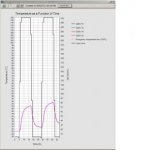illini1022
Member
- Location
- Chicago, IL, US
My primary area of expertise is medium/high voltage power systems, so this is a bit new to me. I'm doing some cursory checks on the sizing of DC conductors at a large solar facility. I'm not the design engineer or independent engineer - I'm really just trying to learn by reviewing these calculations.
Let's say I have modules with a short circuit current rating (at STC) of 9A. Perhaps I'm combining 20 strings in a combiner box and taking it into the input of a large PV inverter. That means the output cable from that combiner box (aka the "PV Output Circuit Current) has an Isc (at STC) of 180A. My read of NEC 690 tells me that I need to take the following steps.
Determining Conductor Ampacity
Sorry for making this a rather wordy post, but I'd appreciate any input/opinions. Thanks.
Let's say I have modules with a short circuit current rating (at STC) of 9A. Perhaps I'm combining 20 strings in a combiner box and taking it into the input of a large PV inverter. That means the output cable from that combiner box (aka the "PV Output Circuit Current) has an Isc (at STC) of 180A. My read of NEC 690 tells me that I need to take the following steps.
- Maximum Circuit Current (690.8A1) = 180A * 1.25 = 225A. This 125% factor is primarily intended to account for the fact that under certain conditions (irradiance/temperature higher than STC), the effective short circuit current may be higher.
Determining Conductor Ampacity
- Per 690.8B
- "PV system currents shall be considered to be continuous." I interpret "continuous" to mean that no load/demand factor is applicable? This seems to be a point of some contention in the industry?
- "Circuit Conductors shall be sized to carry not less than the larger of 690.8B1 or 2." This tells me we need to perform two specific checks and choose the larger conductor of the two.
- For 690.8B1, am I correct in saying that you now must choose a conductor from the NEC tables that can carry 125% of the maximum circuit current calculated above. Effectively - you are using 156% of the STC ISC and picking an appropriate conductor without using any adjustment/correction factors. Presumably, this is to establish a bare minimum conductor size that also aligns with the fact that you'll choose an over-current device rated at, at least 156% of ISC.
- For 690.8B2, you must use the appropriate adjustment/correction/derating factors but the current you compare to remains 125% of the ISC - there is no additional factor of 125% needed for this check.
- Here is where I start to get a little confused. First off - is my interpretation correct?
- Secondly, for complex large setups, it seems more appropriate/accurate to model the exact cable configuration in a software such as Cymcap or Etap. If so, I think the correct input current to use would be ISC*1.25. The NEC derating factors alone don't necessarily account for complicated duct-bank type setups with multiple neighboring conduits containing multiple conductors, etc. Is it appropriate and per code to use a cable simulation software instead of derating tables? Is there some kind of blanket exemption where "engineering guidance" trumps the exact written code for situations like this?
- Digging into the cable simulation scenario a bit more - these software packages will typically ask you to define a load profile or load factor. Obviously these solar cables won't be loaded to 100% 24 hours a day, so if you are making a realistic simulation to check cabel temperature I would think it's technically sound to define a worst case loading profile that simulates the cables running at a very high load for daylight hours and then cooling back down during the night. This loading profile/factor can have a major impact on cable sizing, especially when you are evaluating a choke point such as the entry to an inverter with many DC inputs. When dealing with large cable sizes such as these (500-1000kcmil), the cooldown periods definitely affect conductor ampacity. However, the NEC does say that PV currents are "continuous" so does that present any problems to this logic?
Sorry for making this a rather wordy post, but I'd appreciate any input/opinions. Thanks.


